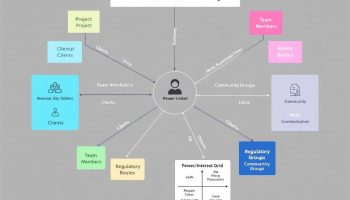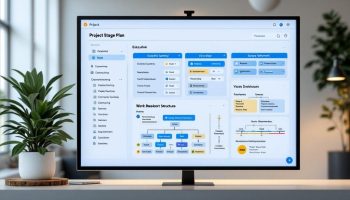
Scope creep, the uncontrolled expansion of project requirements beyond original boundaries, threatens even carefully planned projects. When left unchecked, these gradual changes accumulate, causing missed deadlines, budget overruns, and compromised deliverables that undermine project success.
Why Managing Scope Creep Matters for Business Success
Scope creep poses a significant business risk that directly impacts organizational performance and profitability. When projects expand beyond their intended parameters, you’ll face increased resource allocation, extended timelines, and unpredictable costs that eat into profit margins.
Effective scope management ensures projects deliver expected value while staying aligned with strategic business objectives. By implementing structured controls against unplanned expansion, you can improve project success rates, maintain stakeholder confidence, and achieve more predictable outcomes.
This protection of both reputation and bottom-line results becomes crucial in competitive business environments. Controlling scope creep doesn’t just save time and money—it preserves the integrity of your project vision and helps you deliver what you promised, when you promised it.
According to a study by the Project Management Institute, 37% of projects fail due to scope creep, highlighting its detrimental impact on project success.
Understanding Scope Creep
Scope creep can derail your project by quietly expanding requirements beyond what was initially agreed upon. This happens without proper adjustments to your timeline, resources, or budget. You’re likely familiar with how these small changes accumulate, transforming your once manageable project into something that exceeds all constraints and leaves stakeholders frustrated.
Managing Scope Creep
Controlling scope creep doesn’t mean rejecting all changes; it’s about implementing a structured approach to evaluate and manage modifications throughout your project lifecycle. You’ll need to establish clear boundaries at the start while creating systems that can assess necessary changes without compromising your project’s core objectives.
Effective scope management requires you to distinguish between valuable additions that enhance deliverables and unauthorized expansions that put your project at risk. With the right strategies, you can maintain crucial project boundaries while still accommodating legitimate changes that add value. This balance between flexibility and discipline is essential for preventing scope creep from undermining even your most carefully planned initiatives.
7 Steps to Control Project Scope Creep
1. Establish a Clear Project Scope Baseline
Preventing scope creep begins with a well-defined foundation. You need to document detailed project requirements that clearly outline what will be delivered. Scope creep often emerges when initial requirements lack clarity or detail. Create a comprehensive scope statement that addresses all project dimensions and objectives.
Getting stakeholder sign-off is crucial for stakeholder satisfaction and alignment. Schedule a formal review meeting where all key decision-makers can approve the scope document, creating accountability and shared understanding. This approval process helps minimize future disagreements about what was initially agreed upon.
Set measurable deliverables with specific success criteria to eliminate ambiguity. Your deliverables should include:
- Quantifiable metrics for evaluation
- Clear quality standards
- Specific timeframes for completion
- Defined acceptance criteria
A properly established project scope baseline serves as your reference point throughout the project lifecycle, making it easier to identify and manage potential scope creep before it impacts your timeline or budget.
2. Implement a Change Control Process
Implementing a structured change control process is essential for preventing scope creep from derailing your project. When stakeholders request additions or modifications, a formal system helps evaluate the impact before implementation. Start by creating standardized change request forms that capture all necessary details about proposed changes, including their potential effect on project timelines and budgets.
Establish clear approval workflows to ensure all change requests go through proper evaluation channels. Your workflow should define who needs to review and approve changes based on their potential impact. This systematic approach prevents unauthorized scope changes that often lead to scope creep in projects lacking proper governance.
Document comprehensive impact assessments for each proposed change. These assessments should analyze how the change affects:
- Project timeline
- Resource requirements
- Budget implications
- Quality considerations
- Other project constraints
Track all change requests in a centralized change control log that maintains visibility of modifications throughout the project lifecycle. This tracking system creates accountability and transparency, allowing you to monitor how changes affect the original project boundaries. By implementing these formal controls, you establish a framework that acknowledges legitimate changes while protecting against unmanaged scope expansion.
Expert Insight: Implement a formal change control process to prevent scope creep in projects. Use standardized change request forms and establish clear approval workflows to ensure all modifications are properly evaluated. Maintain a centralized change control log to track requests and assess their impact on timelines, budgets, and overall project objectives.
3. Set Clear Project Boundaries
Establishing firm boundaries is one of the most effective ways to prevent scope creep from derailing your project. When you clearly define what falls outside your project’s parameters, you create a protective barrier against unplanned expansion. Scope creep often begins with seemingly small requests that accumulate over time, gradually pushing your project beyond its original constraints.
Start by explicitly documenting what’s excluded from your project. Create a comprehensive list of specific exclusions that stakeholders can reference when new ideas emerge. For example, if you’re developing a website, clarify that custom animation features or third-party integrations not mentioned in the initial requirements are out of scope.
Develop detailed acceptance criteria for each deliverable to prevent misinterpretations. These criteria should establish exactly what constitutes successful completion, leaving no room for subjective assessment. Consider the following elements when defining your criteria:
- Functional requirements that must be met
- Performance standards that must be achieved
- Quality thresholds that must be satisfied
- Documentation that must be delivered
Set project constraints related to time, budget, resources, and quality. When new requests arise, evaluate them against these established boundaries. This practice ensures that you can confidently redirect stakeholders to the agreed-upon scope when necessary, maintaining control over your project’s direction and preventing unauthorized expansion.
Expert Insight: To prevent scope creep, clearly define project boundaries by documenting exclusions and establishing detailed acceptance criteria for deliverables. Regularly evaluate new requests against these predetermined limits. This proactive approach helps maintain control over your project’s direction and ensures stakeholders adhere to the agreed-upon scope.
4. Practice Regular Scope Monitoring
Effective scope creep management requires consistent monitoring of your project parameters. By scheduling weekly scope reviews, you can identify potential deviations before they escalate into major issues. These regular check-ins help maintain alignment with your project scope baseline and prevent unauthorized changes from sneaking into your project.
Track scope variance carefully by comparing current project activities against your original scope statement. This comparison highlights areas where scope creep might be occurring, allowing you to address it promptly. Document all scope changes, even minor ones, as they provide valuable data for future analysis and can reveal patterns of scope expansion.
When monitoring for scope creep, consider these key practices:
- Compare current deliverables against baseline specifications
- Measure time spent on unplanned activities
- Evaluate new feature requests against original requirements
- Track the impact of approved changes on timeline and budget
Implementing these monitoring practices creates transparency and accountability within your project team. Regular monitoring also demonstrates your commitment to project integration management, ensuring all project elements remain aligned with stakeholder expectations while preventing the gradual expansion that characterizes scope creep.
Expert Insight: To effectively manage scope creep, implement regular monitoring by scheduling weekly scope reviews and tracking deliverables against the original scope statement. Document all changes, however minor, to provide insights for future projects. This proactive approach fosters transparency and alignment with stakeholder expectations, ensuring project objectives remain on track.
5. Maintain Strong Stakeholder Communication
Effective communication is your strongest defense against scope creep. When stakeholders remain informed about project progress and limitations, they’re less likely to introduce unexpected changes. Hold regular status meetings where scope discussions are a standing agenda item, making it easier to identify potential scope creep before it takes root.
Document all decisions related to project scope in writing. This creates a reference point that helps prevent misunderstandings that often lead to scope creep. After meetings, distribute meeting minutes that clearly outline any scope-related conversations and decisions made.
Address stakeholder concerns promptly to prevent them from suggesting scope additions as solutions. When stakeholders feel heard, they’re more likely to work within established parameters rather than pushing for scope expansion.
Share comprehensive progress reports that highlight:
- Completed deliverables against the scope baseline
- Upcoming milestones and their scope boundaries
- Potential scope risks identified by the team
- The impact of any approved scope changes
Maintaining open stakeholder satisfaction channels throughout the project lifecycle ensures everyone understands the consequences of scope changes on timelines, resources, and budgets.
Expert Insight: Maintain strong stakeholder communication by holding regular status meetings focused on scope discussions. Document all scope-related decisions and address concerns promptly to avoid scope creep. This transparency cultivates understanding and trust, ensuring stakeholders are aware of the impact of changes on timelines, resources, and budgets.
6. Develop Risk Management Strategies for Scope Control
Proactive risk management is essential to prevent scope creep from derailing your project. Identifying potential scope-related risks early allows you to establish control measures before changes spiral out of control. When developing your risk management approach, start by creating a comprehensive risk register that specifically tags items that could lead to scope expansion.
To effectively manage scope creep risks, follow these key practices:
- Identify scope-specific risk triggers – Document events or circumstances that might signal potential scope expansion.
- Categorize risks by impact level – Prioritize high-impact scope risks that could significantly affect timeline or budget.
- Assign risk owners – Designate team members responsible for monitoring specific scope risk areas.
- Create detailed mitigation plans – Develop specific strategies for each identified scope risk.
Your risk monitoring should include regular checkpoints to evaluate if triggers are occurring. Effective risk response planning requires updating your assessments as the project evolves. Be particularly vigilant about “scope creep by committee” where multiple stakeholders each request small changes that collectively create significant expansion.
Remember to document all scope-related risks in your risk assessment matrix, with clear contingency plans ready if they materialize. This proactive approach helps maintain scope boundaries while still allowing for necessary flexibility.
7. Create Clear Project Documentation
Comprehensive documentation is your strongest defense against scope creep during project execution. When you maintain detailed requirements traceability, you create a clear connection between project deliverables and initial requirements, preventing unauthorized scope expansion. Each project document should be regularly updated to reflect the current project state, making it easier to identify when scope creep is occurring.
Record all scope decisions with proper context and justification. This practice creates accountability and provides a reference point when stakeholders request changes that may contribute to scope creep. Consider using a document version control system to track changes and maintain historical records of project documentation.
Document lessons learned throughout the project lifecycle, not just at completion. Key insights about scope creep include:
- Patterns of change requests that signal potential scope issues
- Successful strategies for managing stakeholder expectations
- Communication approaches that prevented unnecessary scope expansion
- Areas where initial requirements definition needed improvement
A thorough post-implementation review that examines scope management effectiveness helps prevent similar scope challenges in future projects.
Mastering Scope Creep Management
Scope creep is the gradual expansion of project requirements beyond the initially agreed parameters, often resulting in timeline delays and budget overruns. Effective scope management requires a structured approach that includes establishing clear baselines, implementing change control processes, defining project boundaries, conducting regular monitoring, maintaining stakeholder communication, developing risk strategies, and creating comprehensive documentation. When properly managed, scope changes can be controlled through systematic evaluation that protects project objectives while allowing for necessary flexibility.
Essential Steps for Preventing Project Expansion
- Document detailed project requirements with specific deliverables, success criteria, and exclusions
- Implement a formal change control process with standardized request forms and approval workflows
- Create explicit project boundaries by listing excluded items and detailed acceptance criteria
- Schedule weekly scope reviews to identify deviations before they escalate
- Hold regular stakeholder meetings with scope discussions as a standing agenda item
- Document all scope-related decisions in writing with proper context and justification
- Develop a risk register that specifically identifies potential scope expansion triggers
- Maintain requirements traceability matrices connecting deliverables to initial requirements
- Track change requests in a centralized log to monitor cumulative impact on project parameters
- Conduct thorough impact assessments for each proposed change before approval
Frequently Asked Questions
What exactly is scope creep? Scope creep refers to the gradual, uncontrolled expansion of project requirements beyond what was initially approved, often occurring through small incremental changes that collectively impact timelines and budgets significantly.
How can I recognize scope creep in my projects? Look for signs like increasing deliverables without corresponding adjustments to timeline or resources, stakeholders requesting “just one more small feature,” team members working on undefined tasks, or project deadlines consistently being missed.
Is all scope change considered scope creep? No, not all scope changes are scope creep. Properly managed changes that go through formal evaluation, impact assessment, and approval processes are controlled scope changes, while unmanaged or unauthorized expansions constitute scope creep.
What’s the most effective way to prevent scope creep? Establishing a clear project scope baseline with stakeholder sign-off, combined with a formal change control process, provides the strongest defense against scope creep.
How should I handle stakeholders who repeatedly request scope additions? Maintain firm but diplomatic communication about project boundaries, document all requests through the formal change process, provide impact assessments showing effects on timeline and budget, and offer alternatives like phased implementation or future project phases.
Can scope creep ever be positive for a project? While unmanaged scope expansion is generally detrimental, some scope adjustments can improve project outcomes if properly evaluated and integrated with corresponding adjustments to timeline, budget, and resources.






